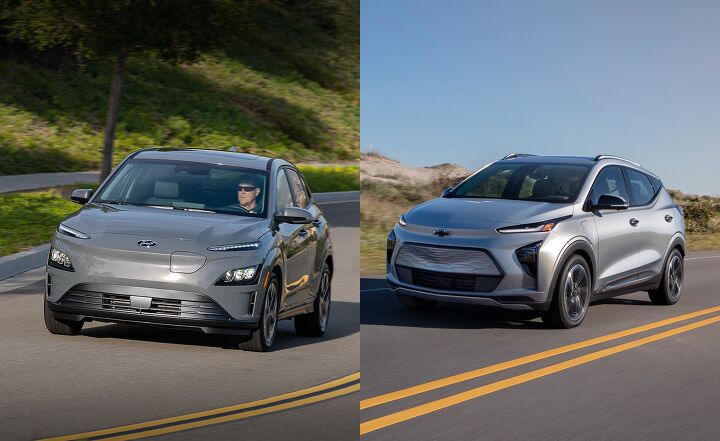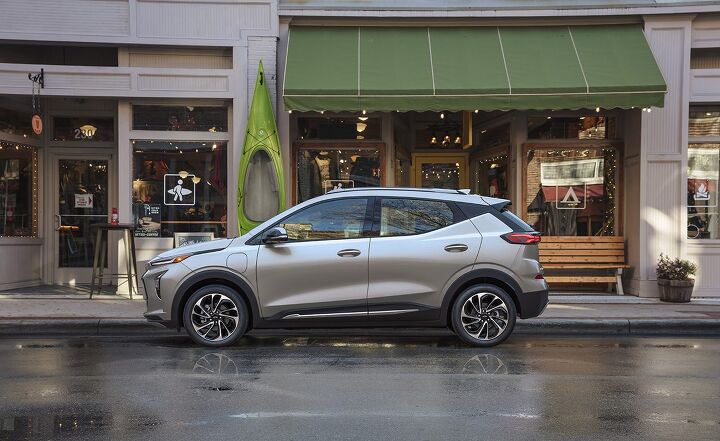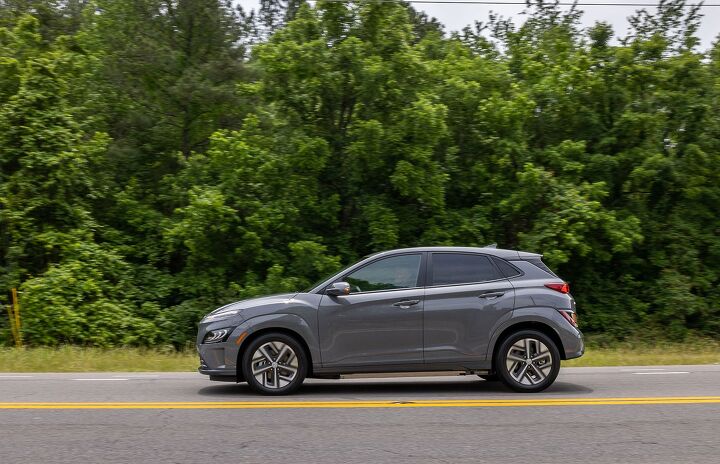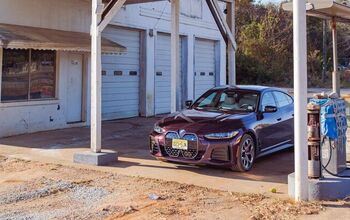Chevrolet Bolt EUV Vs Hyundai Kona Electric: Which Small EV SUV is Right for You?
We take a deep dive through the features and capabilities of two affordable EV SUVs. It’s the Chevrolet Bolt EUV vs Hyundai Kona Electric.
Although the Chevrolet Bolt EUV was a new entry for the 2022 model year, the Kona Electric has been around since 2019. The gasoline powered Kona is a well-reviewed and popular model for Hyundai, and the electric version makes ownership that much more simple.
Get a Quote on a New Chevrolet Bolt EUV or Hyundai Kona ElectricChevy doesn’t have an easy job if it wants to compete with the Kona. Thankfully, another round of price reductions for 2023 should upset the competition and give the Bolt EUV an advantage. We put the two head-to-head to find out which subcompact EV SUV comes out on top.
Style
Chevrolet Bolt EUV: The Bolt EUV spawned out of the redesigned Bolt, looking nearly identical but bigger and taller. Slim headlights draw horizontal emphasis across the front, featuring a solid grille marked by a 3D honeycomb pattern. Around the back, a black horizontal panel blends the tail lights into the rear windscreen and C-pillar.
On the inside, the infotainment screen dominates much of the dash, trimmed in piano black plastic. It’s not a car meant to offend with its aesthetics, but it likely won’t impress many either.
Hyundai Kona Electric: The current Kona design has been with us since the 2018 model year. In its current guise, it sports stacked headlights and a mostly featureless front end. The rear also features a stacked set of lights. The brake lights slim and set up high, while the turn signals/reverse lights are down low.
SEE ALSO: 2019 Hyundai Kona Electric ReviewThe interior is tidy and fuss-free, headlined by the central infotainment screen. The center console is home to the gear selector and cup holders. Thankfully, most essential functions have dedicated buttons.
Bottom Line: While neither car particularly screams premium, the Kona Electric is much more of a design practice than its Chevrolet rival. Both though are due for a refresh in the near future.
Cabin Space
Chevrolet Bolt EUV: In the front of the Bolt EUV, driver and passenger are given 40 inches (1016 mm) of headroom. They also receive 44.3 inches (1125 mm) of leg room, 54.6 inches (1387 mm) of shoulder room, and 51.4 inches (1306 mm) of hip room.
Rear seat passengers get up to 37.8 inches (960 mm) of headroom. Other measures include 39.1 inches (993 mm) of leg room, 52.0 inches (1321 mm) of shoulder room, and 50.2 inches (1275 mm) of hip room.
Hyundai Kona Electric: Front row passengers are allotted 39.6 inches (1006 mm) of headroom in models without a sunroof and 38.0 inches (965 mm) with one equipped. You’ll also find 41.5 inches (1054 mm) of leg room and 53.3 inches (1354 mm) of hip room, with 55.5 inches (1410 mm) of shoulder room for front passengers.
In the back, there are 37.7 inches (958 mm) of headroom. The rest measures in at 33.4 inches (848 mm) of legroom, 52.2 inches (1326 mm) of hip room, and 54.5 inches (1384 mm) of shoulder room.
Bottom Line: You’ll get noticeably more leg room in the Bolt EUV in both rows. But the Kona Electric has more seat width for you to wiggle around in.
Chevrolet Bolt EUV vs Hyundai Kona Electric: Powertrains
Chevrolet Bolt EUV: Only one powertrain configuration is offered by Chevrolet for the Bolt EUV. A single motor drives the front wheels, with an output rated for 200 hp. The system runs off a 65 kWh battery, with no long range options available.
SEE ALSO: 2022 Chevrolet Bolt EV Review: Affordable Electric Does ExistHyundai Kona Electric: All Kona Electrics come with the same powertrain. It’s a 150 kW (201 hp) permanent-magnet synchronous motor driving the front wheels. More impressive, the motor puts down 291 lb-ft of torque. A 64.0 kWh battery is the only battery available.
Bottom Line: There’s no clear winner here. The Bolt EUV and Kona Electric both put down around 200 hp and sport battery packs around the same size.
Efficiency and Range
Chevrolet Bolt EUV: The Bolt EUV is rated for up to 247 miles (398 km) of driving between charges.. In the city, you can see up to 125 MPGe (1.9 Le/100 km) of fuel economy. On the highway, efficiency is a bit lower at 104 MPGe (2.3 Le/100 km). Combined, the Chevrolet is rated for 115 MPGe (2.0 Le/100 km).
Hyundai Kona Electric: Either trim of the Kona Electric is rated for 258 miles (415 km) of range. Hyundai puts the Kona Electric at 132/108/120 MPGe (1.8/2.2/2.0 Le/100 km) for city, highway, and combined economy. The onboard 7.2 kW charger requires 9 hours 15 minutes to charge to full from empty. Or, 47 minutes to charge from 10% to 80% using a 100 kW quick charger.
Bottom Line: The Kona Electric narrowly edges out the Bolt EUV with 11 more miles of range. It also has 7 more MPGe of fuel economy. Under real world driving conditions, those figures may be more or less a negligible difference.
Cargo
Chevrolet Bolt EUV: A Bolt EUV can be loaded up with up to 16.3 cubic feet (524 L) of cargo the rear behind the second row of seats. Should you need more room for flat pack furniture from your favorite Swedish store, folding down the back row opens up 56.9 cubic feet (1611 L) of room of storage potential.
SEE ALSO: No Need To Wait Until 2023, 2022 Chevy Bolt EUV And Bolt EV Are Already DiscountedHyundai Kona Electric: With five people inside the car, you are able to toss in 19.2 cubic feet (544 L) worth of luggage behind the rear seats. Throwing out the passengers in the back and folding down the seats will grant you up to 45.8 cubic feet (1297 L) of space for flat pack furniture and dogs.
Bottom Line: The Kona Electric has a larger rear cargo area than the Bolt EUV. But folding down the second row reveals a big advantage in storage for the Chevy.
Chevrolet Bolt EUV vs Hyundai Kona Electric: Safety
Chevrolet Bolt EUV: A basic Bolt EUV keeps it simple with 10 airbags and Lane Keep Assist with Lane Departure Warning. Optional packages on the LT bring the Chevy up to par by including Lane Change Alert with Side Blind Zone Alert, Rear Park Assist, and Rear Cross Traffic Alert. The Premiere includes all safety features available on the LT, but adds Surround Vision, and Adaptive Cruise Control. The Bolt EUV also has the possibility to add the Super Cruise semi-autonomous function as an option.
Hyundai Kona Electric: All Kona Electric models come standard with Blind-Spot Collision-Avoidance and Rear Cross-Traffic Collision Assist. There’s also Forward Collision-Avoidance with Pedestrian Detection, Lane Keeping Assist, Lane Following Assist, Driver Attention Warning, and Safe Exit Warning. The Limited trim adds Reverse Parking Distance Warning.
Bottom Line: A bare bones Bolt EUV is decidedly less expensive than the most basic Kona Electric. But it lacks many of the modern safety features that usually come as standard. Start adding in the options and it becomes more evenly matched. Though, the range topping Bolt EUV Premiere bests the Kona Electric by offering the same level of safety tech at a much lower price.
Tech and Features
Chevrolet Bolt EUV: The most stripped down Bolt EUV will come with automatic climate control, ambient lighting, a 6-speaker audio system, and wireless Apple CarPlay and Android Auto as standard. Several equipment packages are available for the LT, allowing for the addition of features. These include a power-adjustable driver seat, heated front seats, heated steering wheel, and auto dimming mirrors. The Premiere features everything on the LT as well as heating for the rear seats. Keep adding on the bucks and you can also option the Premiere with a premium Bose audio system and navigation.
Hyundai Kona Electric: As standard, the base SEL trim is equipped with an 8-inch touchscreen, wireless Apple CarPlay/Android Auto, and automatic climate control. Opting for the Convenience Package on the SEL will add an 8-way power adjustable driver seat, heated seating for the front row, wireless device charging, and a sunroof.
SEE ALSO: Hyundai’s Unveiling a New Concept Car Next WeekThe more premium Limited trim comes with most things found in the SEL Convenience Package,. But it also adds ventilated front seats, leather seating surfaces, Smart Cruise Control with Stop & Go, Dynamic Voice Recognition, and swaps the 8-inch infotainment screen for an 10.25-inch unit with Harman Kardon audio. Oddly enough, wireless Apple CarPlay/Android Auto is removed and unavailable with the Limited trim.
Bottom Line: Chevy and Hyundai go toe to toe in the tech and equipment category. Both offer nearly the same level of features at each respective trim level. This category is a virtual tie.
Pricing
Chevrolet Bolt EUV: The Bolt EUV receives significant price reductions for 2023. The more sparsely equipped LT trim level now starts from $27,200 plus $995 in destination charges. For those looking to add a few more options to their Bolt EUV, the Premiere trim is priced from $32,695 with destination charges included.
Hyundai Kona Electric: A base Kona Electric SEL will start from $34,000 plus $1,295 in destination charges. The optional Convenience Package which includes a sunroof, heated front seats, and wireless device charging adds $3,500 on the SEL trim. The Limited trim will set you back $43,795 including destination.
Bottom Line: It’s hard to back the Kona Electric when the Bolt EUV is priced $7,000 to $11,000 less than its Hyundai counterpart. Especially considering the amount of technology packed into the Premiere trim of the Chevrolet.
Chevrolet Bolt EUV vs Hyundai Kona Electric: Conclusion
Offering spry handling and a functional interior, the Kona is a popular choice for buyers in the subcompact SUV segment. The Kona Electric trades internal combustion for an electric motor, while still giving it most of the same packaging and driving dynamics.
Chevrolet is eager to make the Bolt and Bolt EUV the first stepping stone for many just getting into the EV market. The brand’s hefty price reduction on 2023 models make for an unbeatable value, and gives the Bolt EUV the edge in this head to head.
Become an AutoGuide insider. Get the latest from the automotive world first by subscribing to our newsletter here.
More by Harry Zhou

















































Comments
Join the conversation
The cargo area in the Bolt can be lowered by removing the floor and moving it downward. This adds maybe 8-10 more cubic feet of room.
The floor of the cargo area?